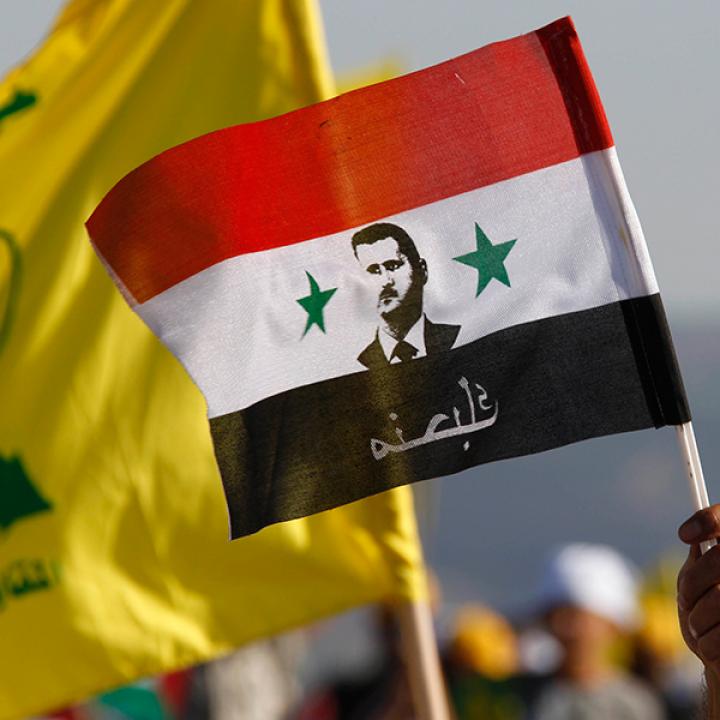
- Policy Analysis
- Policy Alert
Assessing the Reported Pantsir Delivery to Hezbollah

The antiaircraft system poses a manageable risk to Israeli operations along its northern border, but Washington must show Moscow and its associates that any benefits to such escalation are not worth the costs.
On November 2, reports surfaced concerning the potential transfer of a Russian-built Pantsir S-1 (NATO SA-22) antiaircraft system from Wagner Group paramilitary forces in Syria to Hezbollah in Lebanon. A later report that indicated that Syrian president Bashar al-Assad had consented to the transfer, a development the Kremlin denies. Militarily, the transfer of a short-range antiaircraft gun and missile system to Hezbollah threatens only to complicate Israeli low-altitude freedom of maneuver—including possibly its long-range drones and air-to-ground weapons—along its northern border amid heightened tensions fueled by the Gaza crisis. Politically, however, the Pantsir system’s possible introduction into Lebanon suggests the latest convergence of Russia-Iran policy on Israel and the United States—as well as Syria’s role as an Iranian arms hub and emerging battleground between America and Iran-backed groups as the Gaza crisis unfolds.
The delivery of sophisticated weapons systems from Syria to Hezbollah is nothing new, as witnessed in the steady buildup of the Iranian proxy’s rocket and missile inventories, now numbering in the thousands. Indeed in March 2010, President Assad provided Hezbollah with Scud missiles, strategic weapons that his father, Hafiz al-Assad, had long held back as part of his calibrated brinkmanship over Lebanon that constrained Hezbollah’s fighting ability and made the Syrian leader the indispensable arbiter of regional and international efforts to stabilize the Levant.
As Syria descended into war and de facto partition, the aid of Iran-backed proxies to Assad at key moments led to his deepening relationship with Hezbollah. Yet whereas Russia’s 2015 military intervention in Syria halted territorial losses by the Assad regime and its Hezbollah and Iranian militia supporters, this assistance came with a price. Russian president Vladimir Putin’s functional relationship with Israel allowed for the relatively unimpeded flight of Israeli aircraft over Syrian and Lebanese territory to target Iranian weapons shipments. This freedom of maneuver has become increasingly important since the outbreak of the Gaza crisis on October 7, leading Israel to carry out multiple high-profile strikes on Syrian territory. These notably have closed the country’s largest airports, in Aleppo and Damascus, which are often used by Iran to ferry weapons into the country.
The future of the Wagner Group is uncertain following the mutiny and eventual death of its leader Yevgeny Prigozhin in summer 2023, but the paramilitary group continues to operate in Syria, reportedly under the direction of the Russian Ministry of Defense. Recent Russian reports suggest that the group has resumed enlistment within Russia. As for the Pantsirs, whoever was responsible for the transfer—whether Wagner or another faction connected with the Defense Ministry—it indicates the Kremlin feels increasingly unconstrained to escalate with the United States and its allies in the context of the Israel-Hamas war, either directly or through proxies.
On a geopolitical level, the reported transfer shows that Moscow is seeking to exploit the chaos of wartime while sowing divisions within the United States and the West. Such a move is not surprising given heavy Russian losses during the long slog in Ukraine and the Kremlin’s growing alignment with the “Global South,” especially Iran. The November 2 passage by the U.S. House of Representatives of a separate bill on Israel aid, omitting aid to Ukraine despite President Biden’s intention to pair the two, likely only reinforced the perception of American and Western divisions over foreign policy.
Moscow appears to have that calculated the benefits of escalation are worth the costs of deteriorating relations with Israel. Over the past year, as expressed by Putin and in Russian official rhetoric, Moscow believes it is fighting an existential battle with the West, with Syria serving as just one theater in the contest to replace the U.S.-led world order with a multipolar one. Regardless of the outcome of the potential air-defense transfers to Hezbollah, the Kremlin—espousing a global-strategic perspective—will continue to find ways to intimidate, harass, or distract the United States and its allies. Washington thus needs to show Moscow that the benefits of escalating are not worth the price—indeed, that such a fight would be unsustainable.
To clearly demonstrate such costs, the United States and Israel need to hold Russia’s patron Assad accountable publicly and militarily. The introduction of Pantsir S-1s, one should note, is not a game changer so much as a prominent symbol of Russian support for Hezbollah and Iran vis-à-vis Israel. It can be fairly easily managed at this early stage of the Gaza conflict.
As a practical matter, press reports outlining Assad’s and Hezbollah’s potential moves are important for marshaling diplomatic and political support against the transfers, but are unlikely to deter the Syrian leader from allowing them. Washington’s response should thus be twofold. First, it should test its regional allies’ recently rekindled ties with Assad by sending direct messages not only through the United Arab Emirates but also through Saudi Arabia to stop current and future transfers. Second, the United States should coordinate with Israel on military action to neutralize the system without injuring Russian personnel, possibly in the Hezbollah-controlled zone along Lebanon’s eastern frontier with Syria. Such decisive, calculated action would show Putin, Assad, Hezbollah, and their associates that such military transfers along Israel’s northern border will not go unanswered.
Andrew Tabler is the Martin J. Gross Senior Fellow at The Washington Institute and former director for Syria on the National Security Council. Anna Borshchevskaya is a senior fellow in The Washington Institute’s Diane and Guilford Glazer Foundation Program on Great Power Competition and the Middle East.




